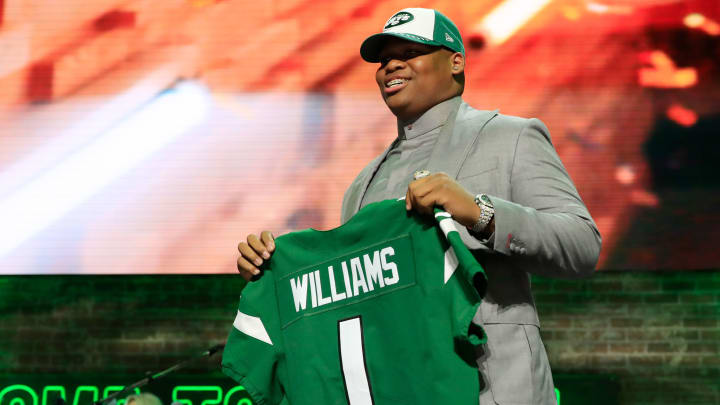NFL Draft's College Football Takeaways: SEC, Clemson D-Line Steal the Show in Round 1

Six rounds of the NFL draft remain. And if you’re a fan of college football, you’re excused for not planning your weekend around the remaining hundreds of picks. On Thursday night, though, all eyes were on Nashville and the first 32 players off the board, who ranged from college fan favorites like Christian Wilkins to unknowns like Tytus Howard. It’s time to finally say goodbye to some of the best players in the college game from 2018. But before we do that, here’s a look at the draft from a college-centric perspective, looking at everything from conference supremacy to the players we wish we’d seen more of on a bigger stage.
Among Power 5 conferences, the SEC (as usual) did the best, the Pac-12 and Big 12 the worst. The SEC saw nine players drafted, the Big Ten and ACC each had seven, and the Big 12 and Pac-12 had three apiece.
Clemson’s defensive linemen came off the board in an unexpected order. College football fans have had the privilege of enjoying the Tigers’ ridiculous defensive line for the past three seasons, and before we collectively mourn the fact that the trio of Wilkins, Dexter Lawrence and Clelin Ferrell are gone to the NFL, let’s take a look at how they fared in the draft. In the weeks leading up to the event, most mock drafts predicted Wilkins would be the first of the three to go, toward the end of the top 10—or maybe even later.
Then the Raiders took Ferrell fourth. It was an unexpected move, though anyone who watched Clemson in any kind of detail these past few seasons knows there’s probably an argument for any of the three D-linemen to go first, and this high. Ferrell grades out far better as a pass-rusher—he’s elite in that phase of the game—than as a run-stopper, which might have pushed him farther back in the first round. But Oakland liked what it saw.
Wilkins came next, to the Dolphins with the 13th pick, and Lawrence went to the Giants at No. 17. That’s right: all three guys were top-20 picks.
Not one, but two Iowa tight ends were taken in the first 20 picks. T.J. Hockenson went first, at No. 8 to the Lions, and 12 picks later, Noah Fant joined the Broncos. It’s rare that two tight ends go off the board in the first round—this year was only the second time that’s happened since 2010—and basically unheard of for two tight ends from the same college team to both be picked on Thursday night. That says a lot about Iowa’s offense under coordinator Brian Ferentz, which hasn’t exactly been a world-beater these past few seasons but produced these two top picks.
Hockenson played just two seasons at Iowa, but he was the team’s leading pass-catcher in 2018, logging 760 yards on 49 receptions. He made his name as a run blocker, too—but you’re excused if you didn’t follow his career closely on a Hawkeyes offense that ranked 92nd of 130 teams in total offense last fall. Meanwhile Fant, who came in with Hockenson in 2016 but did not redshirt, played three seasons, and his production was remarkably consistent between 2017 and ’18, with 494 and then 519 total yards.
The Nick Bosa method works. We already knew this. It was no surprise when Bosa, who elected not to return from a September injury and train for the draft instead, went second overall to the 49ers. But now that his plan went as well as he could have expected, there’s cause to wonder how many more elite players might follow a similar route to the NFL in the future.
Brian Burns is the first-rounder I wish I’d watched more in college. Burns, who went 16th to Carolina, is a 6’5”, 250-pound edge rusher from Florida State. He’s physically imposing and should start next season for the Panthers—so there will be ample opportunity to appreciate his game in the NFL. At the college level, though, he played the bulk of his snaps for underwhelming Seminoles teams. Sure, Florida State went 10-3 in Burns’s freshman year, but he was only beginning to come into his own then. In 2017 and ’18, the team struggled, and Burns was perhaps its brightest spot. As a sophomore, he logged 13.5 tackles for loss, and as a junior, he rang up 15.5. He also had 10 sacks last fall, along with three forced fumbles and three passes defended.
The Power 5 reigned supreme, but the FCS got a surprise pick. In recent years, there has been a Group of 5 (or even, in the case of Carson Wentz, FCS) darling taken in the first round—guys who were under-recruited out of high school and played their careers under the radar in Conference USA or the MAC before being discovered during the pre-draft process. Such players are endlessly discussed during the leadup to the draft. They become household names. This year, there was no such guy—but the non-Power 5 first-round picks were still interesting in their dichotomy.
First, Ed Oliver came off the board with the ninth pick—but he hardly fits the typical Group of 5 or FCS mold. Oliver was a five-star recruit out of high school who chose Houston in large part because of its up-and-coming coach, Tom Herman, and because it was his hometown team. If you watch football, you knew Oliver’s name long before February.
Then, with the 23rd pick, the Texans picked Tytus Howard, an Alabama State—yes, you read that right—offensive tackle who appeared in the first round of, shall we say, very few mock drafts. Howard, who played high school quarterback and put on 87 pounds in college after walking on, is certainly a developmental pick, the kind of guy who’s going to get some time to learn and grow into his role.
In the end, Howard and Oliver were the only two players from non-Power 5 schools (or Notre Dame; defensive tackle Jerry Tillery went 28th) selected. By comparison, there were five players from Group of 5 teams taken in the first round a year ago.
Alabama tied for the most first-rounders—but had fewer than it did a year ago. In the past two drafts, Alabama has produced more first-round picks than any other program, with four each in 2017 and ’18. When Quinnen Williams went third overall Thursday, he became the highest-drafted Crimson Tide player since Trent Richardson went at that same spot, to the Browns, in 2012. On the night, Alabama saw three players drafted: Jonah Williams went 11th to the Bengals, and Josh Jacobs was the first running back off the board when the Raiders selected him at No. 24.
Again, Alabama was the team with the most first-rounders—but this year, another SEC program tied it. Mississippi State had three players, all defenders, taken as well. If you watched college football last year, that should come as no surprise. After all, the Bulldogs allowed opponents the fewest overall yards and yards per play of any team in 2018. And here’s a wild comparison: Prior to 2019, Mississippi State had seen exactly 10 of its players drafted in the first round. Meanwhile, Alabama has had 10 first-round picks since 2015.
